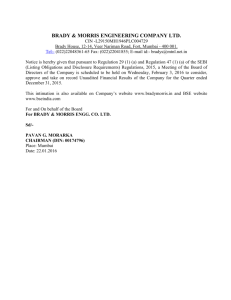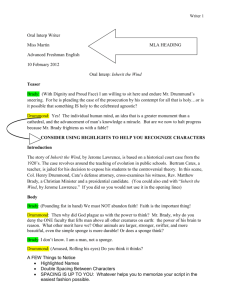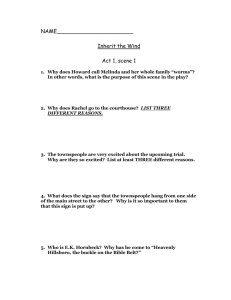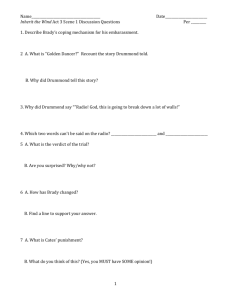Document 13876691
advertisement
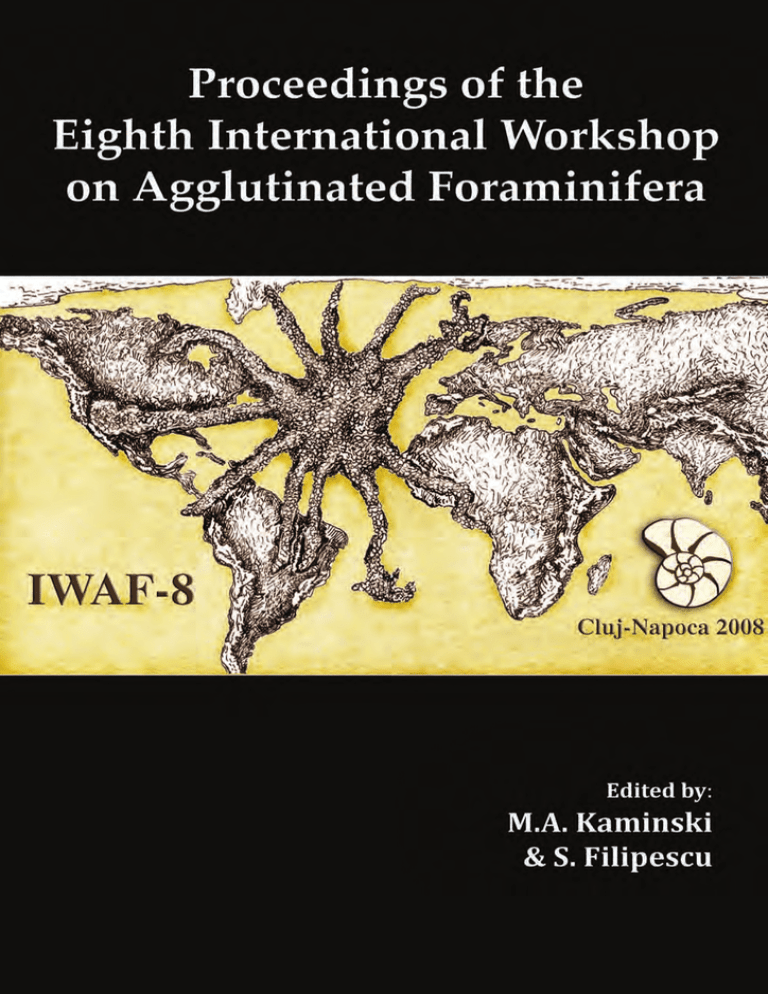
Proceedings of the Eighth International Workshop On Agglutinated Foraminifera (Cluj-Napoca, Romania, September 7-13, 2008) Edited by Michael A. Kaminski Earth Sciences Department, King Fahd University of Petroleum & Minerals, Dhahran, 31261, Saudi Arabia and Sorin Filipescu Department of Geology, Babeș–Bolyai University, Str. Kogălniceanu 1, Cluj-Napoca, 400084, Romania Published by The Grzybowski Foundation Grzybowski Foundation Special Publication No. 16 61 Lectotypes of type species of Agglutinated Foraminiferal Genera in the Collections of the Natural History Museum, London. Part 2. Hippocrepinina and Hormosinina MICHAEL A. KAMINSKI1& CLAUDIA G. CETEAN2 1. Department of Earth Sciences, University College London, Gower Street, London WC1E 6BT, U.K; e-mail: m.kaminski@ucl.ac.uk. Current address: Earth Sciences Department, King Fahd University of Petroleum & Minerals, Dhahran. 31261, Saudi Arabia; e-mail: kaminski@kfupm.edu.sa 2. Department of Palaeontology, Natural History Museum, Cromwell Road, London, SW7 5BD, U.K. ABSTRACT We herein illustrate and designate lectotypes and report the current status of other type specimens (lectotypes and neotypes) for the type species of five agglutinated genera belonging to the order Hippocrepinina and 12 genera belonging to the order Hormosinina that are housed in the micropalaeontological collections of the Natural History Museum, London. These are the hippocrepinid genera Jaculella, Botellina, Hyperammina, Protobotellina, and Saccorhiza, the hormosinellid genera Ammolagena, Archimerismus, Hormosinella, Reophanus, and Subreophax, and the hormosinid genera Cuneata, Hormosina, Hormosinelloides, Loeblichopsis, Nodulina, Pseudonodosinella, and Reophax. INTRODUCTION As part of a larger project to revise and update the Genera of Agglutinated Foraminifera, we have investigated the status of the type specimens agglutinated foraminiferal genera housed in the micropalaeontological collections of the Natural History Museum, London. This work is being carried out in order to underpin the generic taxonomy of the agglutinated foraminifera to serve as the basis for future taxonomic studies. As a first step towards this revision, Kaminski et al. (2008) established the status of the “generic types” of the type species belonging to the orders Astrorhizina and Saccamminina housed in the Department of Palaeontology at the Natural History Museum, London. The purpose of the current paper is to review the status of generic types belonging to the orders Hippocrepinina and Hormosinina. Part of the task of lectotypification of generic types belonging to this order has already been accomplished during the taxonomic work for the “Treatise of Invertebrate Paleontology, part C” by Loeblich & Tappan (1964), and for the “Atlas of Paleogene Cosmopolitan Agglutinated Foraminifera” by Kaminski & Gradstein (2005). Our ultimate goal is to complete the revision and lectotypification of generic types in a systematic manner. METHODS A number of classic foraminiferal collections are housed in the micropalaeontological collections of the Natural History Museum, London, including collections of Brady, Brönnimann & Whittaker, Carpenter, Collins, Heron-Allen & Earland, Norman, and Parker & Jones. The larger “Brady Collection” is of particular importance because H.B. Brady received syntypic specimens from his collaborators, as in the case of Reophax cylindrica. We examined these archived microscope slides in order to search for specimens that best fit the original descriptions and illustrations of the described genera. In many cases, we were able to identify the specimens that were illustrated by the original author, or by the first reviser. Specimens were photographed in reflected and transmitted light at the Natural History Museum. Images were produced using a Zeiss Axiocam mounted on a Leica MZ16 microscope with Axiovision software. SYSTEMATIC TAXONOMY Suborder HIPPOCREPININA Saidova, 1981 Superfamily HIPPOCREPINACEA Rhumbler, 1895 Family HIPPOCREPINIDAE Rhumbler, 1895 Jaculella Brady, 1879 Plate 1, figs 1-3 Type species. Jaculella acuta Brady, 1879; OD(M). Description. Test free, large, elongate, conical, tapering, up to 12 mm in length. Wall coarsely agglutinated, thick, firmly cemented, both exterior and interior surfaces roughly finished. Aperture rounded, at slightly constricted open end of tube. Remarks. Loeblich & Tappan (1964) designated and figured the lectotype of Jaculella acuta from In: Kaminski, M.A. & Filipescu, S., (eds), 2011. Proceedings of the Eighth International Workshop on Agglutinated Foraminifera. Grzybowski Foundation Special Publication, 16, 61-69. 62 Challenger sta. 122 (SE of Pernambuco, 350 fathoms). This specimen was figured by Brady (1879, pl. 3, fig. 12), and is preserved in the Brady Collection in slide 1966.2.11.5. Five paralectotypes are preserved in slide BMNH ZF 1602 (including the sectioned specimen figured by Brady (1879, pl. 3, fig. 13), and another 10 whole and fragmentary paralectotypes are housed in slide ZF 1603. The syntypes have a wall constructed exclusively of quartz grains, one or two grains thick, arranged in a masonry pattern. Family BOTELLINIDAE Chapman & Parr, 1936 Botellina Brady, 1881 Plate 1, figs 4-6 Type species. Botellina labyrinthica Brady, 1881a, p. 48; SD(SM). Description. Test free, large, 3 mm in breadth, broken specimens suggesting a total length of up to 25 mm, rounded proloculus followed by elongate tubular, nearly parallel-sided undivided chamber that may be of less diameter than the proloculus. Wall agglutinated, compact, and firmly cemented, of quartz grains and commonly with sponge spicules that may protrude into the chamber cavity. Aperture terminal, rounded; may be somewhat constricted. Remarks. We transfer authorship of the genus to Brady, as the original use of this name by Carpenter et al. (1870) was a nomen nudum. Several slides of syntypes of Botellina labyrinthica are housed in the Brady and Carpenter Collections. These are from Porcupine sta. 51, 440 fathoms in the Faroe Channel. The syntype figured by Loeblich & Tappan (1964) is preserved in Slide ZF 1234, and additional specimens figured by Brady (1884) are preserved in Slide 1959.5.5.178-183. The lectotype, designated herein, is the whole specimen in this slide illustrated by Brady (1884, pl. 29, fig. 8). As shown by Hofker (1972, p. 4), the wall of Botellina is not labyrinthic as originally described; sponge spicules projecting into the central cavity from the wall and quartz grains loosened within the cavity in the process of sectioning may give the erroneous impression of a labyrinthic interior. Protobotellina Heron-Allen & Earland, 1929 Plate 1, figs 7-8 Type species. Protobotellina cylindrica Heron Allen & Earland; OD. Description. Test free, large, tubular or cylindrical, open only at one end, aboral end truncate; wall thick, agglutinated, of fine sand and broken sponge spicules with little cement, exterior smoothly finished but interior rough, with sponge spicules protruding into the cavity; aperture terminal, irregular in outline, and M.A. Kaminski, C.G. Cetean may be partially obstructed by sponge spicules and other agglutinated particles. Remarks. The lectotype designated by Loeblich & Tappan (1964) is from Discovery Station no. 231, Falkland Islands (50º 10' 00"S, 58º 42' 00" W) and is preserved in the Heron-Allen Collection in Slide ZF 3566. This is the specimen figured by Heron Allen & Earland (1929, pl. 2, fig. 10). Family HYPERAMMINIDAE Eimer & Fickert, 1899 Hyperammina Brady, 1878 Plate 1, figs 9-10 Type species. Hyperammina elongata Brady, 1878; OD(M). Description. Test free, elongate, reaching a maximum length of about 16 mm, large proloculus followed by undivided tubular chamber of constant diameter but tapering slightly at the end to the rounded aperture; wall of agglutinated medium-sized quartz particles that may be firmly to loosely cemented, interior cavity with smoothly finished surface. Remarks. A lectotype for H. elongata was designated by Loeblich & Tappan (1964), and corresponds to the specimen illustrated by Brady (1878, pl. 20, fig. 2a). The syntypes are from Austro-Hungarian North Polar Expedition of 1875-76, station at Cape Frazer, 80 fathoms. The lectotype is preserved in the Brady Collection in slide ZF 3604. Saccorhiza Eimer & Fickert, 1899 Plate 1, figs 11-12 Type species. Hyperammina ramosa Brady, 1879, p. 33; OD(M). Description. Test large, up to 8 mm in length, proloculus followed by tubular chamber that may branch dichotomously or show very irregular growth, with terminal stoloniferous projections. Wall of agglutinated quartz grains and other minerals held in an organic inner layer, commonly with a large component of outwardly projecting sponge spicules that give the surface a hirsute to felt like appearance, dark gray to yellowish in colour; aperture rounded, at the open ends of the stolonlike branches. Remarks. The lectotype of Hyperammina ramosa was designated by Loeblich & Tappan (1964) from Challenger sta. 246 (N. Pacific at 2050 fathoms) This is the specimen illustrated by Brady (1879, pl. 3, fig. 15), and is housed in the Brady Collection in Slide ZF 3612. Hofker (1972, p. 53) suggested restricting Saccorhiza to those specimens with a surface covered with matted sponge spicules, stating that Brady's specimen figured from the North Pacific did not belong to the same taxon. However, this specimen was earlier designated as the lectotype for this species Lectotypes of Agglutinated Foraminifera in the NHM London. Hippocrepinina and Hormosinina (Loeblich & Tappan, 1964, p. C190), hence cannot be excluded from the taxon bearing this name. Suborder HORMOSININA Mikhalevich, 1980 Rauser & Superfamily HORMOSINELLACEA Reitlinger, 1986 Family AMMOLAGENIDAE Kaminski, Henderson, Cetean & Waskowska, 2008 Ammolagena Eimer & Fickert, 1899, emend. Kaminski, Henderson, Cetean & Waskowska, 2008 Type species. Trochammina irregularis (d'Orbigny) var. clavata Jones & Parker, 1860, p. 304; OD(M). Description. Test commonly attached to shell fragments or to other foraminifers, up to 2 mm in length, large ovoid proloculus followed by narrower tubular rectilinear chamber, rarely linked to form a pseudomultichambered chain. Wall finely agglutinated on an inner proteinaceous layer, originally reddish-brown in colour, turning grey or white in fossil forms, surface smoothly finished and glossy. Main aperture terminal, rounded, at the open end of the tube. A smaller secondary opening may be present at the base of the proloculus. This opening may serve as a connection between chambers in multichambered specimens. Remarks. A lectotype for the type species from the Jones & Parker collection was designated by Kaminski & Gradstein (2005). This specimen was collected in the Mediterranean Sea, near Malta, and is preserved in slide ZF 4873. Kaminski et al. (2008) noted the pseudo-multichambered nature of the test and removed the genus from the Ammodiscidae, placing it into the new hormosinellid family Ammolagenidae. Family HORMOSINELLIDAE Rauser & Reitlinger, 1986 Archimerismus Loeblich & Tappan, 1984 Plate 1, figs 13-15 Type species. Hyperammina subnodosa Brady, 1884, p. 259; OD. Description. Test large, elongate, with globular proloculus followed by elongate tubular pseudochambers, with somewhat irregular size increase, separated only by constrictions of the wall that do not form true septa. Wall agglutinated, thin at the base of the proloculus, becoming thicker toward the aperture, and many grains thick in the remainder of the test, of coarse quartz grains firmly held in a small amount of cement, with inner proteinaceous layer. Aperture terminal, rounded, at the somewhat constricted end of the final chamber. Remarks. Three slides of type specimens of Hyperammina subnodosa are preserved in the Carpenter Collection, all from Valorous sta. 2, at 100 fathoms. The 63 lectotype is the specimen illustrated by Brady (1884, pl. 23, fig. 11), and is preserved in Slide 1886.4.16.94. Archimerismus differs from Hormosina in the subcylindrical test and incompletely separated chambers and differs from Hyperammina in the partial subdivision of the test to form chambers. Rockfordina Rauser & Reitlinger, 1986, [type species Reophax lacrymosus Gutschick & Treckman, 1959] was described as having a test consisting of pyriform pseudochambers, separated solely by constrictions of the wall. In our view, this genus is synonymous. Hormosinella Shchedrina, 1969 Plate 1, figs 16-17 Type species. Reophax distans Brady, 1881, p. 50; OD. Description. Test free, large, uniserial, and rectilinear to slightly arcuate; ovate to fusiform chambers separated by very elongate, delicate, and stolonlike necks, commonly broken, although a three-chambered test may attain a length of 5 mm. Wall agglutinated, very thin, of a single layer of well-cemented grains. Aperture terminal on the elongate neck, rounded. Remarks. The lectotype of the type species was designated by Kaminski & Gradstein (2005), and is preserved in the Brady Collection in Slide ZF 2271. Reophanus Saidova, 1970 Plate 2, figs 1-3 Type species. Hormosina ovicula Brady, 1879, p. 61; OD. Description. Test large, up to 4 mm in length, uniserial, rectilinear, moniliform in appearance because the elongate ovate chambers are separated by their respective necks, each new chamber attaching to the upper margin of the previous apertural lip, so that the test is fragile and rarely preserved entire. Wall agglutinated, thin, but with several layers of very fine quartz grains and some sponge spicules, yellowish to brownish in colour, without organic lining. Aperture rounded, terminal on a distinct neck, with somewhat flared lip. Remarks. The syntype specimens of Hormosina ovicula are preserved in the Brady Collection. The lectotype, designated herein, is the specimen illustrated by Brady in pl. 39, fig. 7. This specimen was designated the “holotype” by Loeblich & Tappan (1987), and is preserved in slide ZF 1588. The specimen is from Challenger sta. 241, North Pacific at 2300 fathoms. The type species of this genus was included in the genus Hormosinella by Shchedrina (1969), but the two genera are differentiated by their wall character, as Hormosinella has a single layer of grains in the wall, whereas Reophanus possesses a wall that is finer grained but many grains thick. 64 M.A. Kaminski, C.G. Cetean Subreophax Saidova, 1975 Plate 2, figs 4-6 Type species. Reophax aduncus Brady, in Tizard & Murray, 1882, p. 715; OD. Description. Test large, up to 2.5 mm in length, consisting of an irregular series of very slowly enlarging ovoid to subpyriform pseudochambers, separated solely by constrictions of the wall but without distinct internal septa. Wall thin, agglutinated with larger grains in a single layer and held in little cement; aperture terminal. Remarks. The syntypes illustrated by Brady (1884) are preserved in the Brady Collection in slides ZF 2256 –2259. The lectotype, designated herein, is from Porcupine sta. 28 (1215 fathoms), and is the specimen illustrated by Brady (1884, pl. 31, fig. 23) and it is preserved in slide ZF2256. dant cement, outer coarser material restricted to the chambers and not continuing onto the neck, which thus shows a sharply decreased grain size. Aperture terminal at the end of a distinct tubular neck, later chambers overlapping the previous ones to enclose the neck. Remarks. The lectotype, designated herein, is the five-chambered specimen illustrated by Brady (1884, pl. 39, fig. 4) and is from Porcupine sta. 23, NW of Ireland (630 fathoms) and is preserved in the centre of Slide ZF 1584. The two-chambered specimen originally illustrated by Brady (1879, pl. 4, fig. 5), is preserved in Slide ZF 1582. Three additional unfigured paralectotypes are also present in the slide. Syntypes from Challenger Sta. 24 (390 fathoms off Culebra Island) are larger, with as many as five chambers. Superfamily HORMOSINACEA Haeckel, 1894 Family CUNEATINAE Loeblich & Tappan, 1984 Hormosinelloides Zheng, 2001 Plate 2, figs 10-12 Type species. Reophax guttifera Brady, 1884, p. 278. OD. Description. Test free, uniserial, straight to slightly curved. Chambers globular to pyriform, the first two appressed, the following ones separated by short stolonlike necks. Chambers overlap, with each succeeding chamber attached near the base of the apertural neck of the preceding one. Wall thin, consisting of coarse sand grains and sponge spicules. Cement organic, undifferentiated, with an inner and outer organic layer. Aperture terminal at the end of the neck. Remarks. Kaminski & Gradstein (2005) designated the lectotype of H. guttifer, which is preserved in the Brady Collection in Slide ZF 2276. Hormosinelloides resembles Subreophax because of its slightly meandering test. However, in our opinion it is closer to Reophax because of the nature of connections between chambers. In H. guttifer the chambers embrace, (i.e., they are attached near the base of the apertural neck of the preceding one). In dissected specimens the end of the apertural neck of the older chamber can be seen to protrude into the chamber lumina of the following chamber. By contrast, in both Subreophax and Hormosinella, chambers are separated solely by stolons formed by constrictions of the wall (chambers do not overlap). Cuneata K.V. Fursenko, 1979 Type species. Reophax arctica Brady, 1881, p. 99; OD. Description. Test small, elongate, uniserial, rectilinear, laterally compressed so that the test is ovoid in section, early chambers increasing rapidly in breadth but slowly in height, later increasing more rapidly in height and more slowly in breadth and with nearly parallel margins. Wall thin, finely agglutinated, with occasional larger grains forming a single layer, imperforate, white to gray in colour, smoothly finished. Aperture terminal, an elongate slit with lenticular outline and slightly produced margins. Remarks. The lectotype of Reophax arctica was designated by Brönnimann & Whittaker (1980) and is preserved in slide ZF 3996 (labeled Obidolina arctica). The specimen is from the Austro-Hungarian North Polar Expedition sta. 503, collected off the NW coast of Novaya Zemliya at 130 m. Specimens from the type locality are very delicate with an extremely thin wall (< 5 µm). Brady (1881b) drew the species with a circular aperture, but the lectotype and paralectotypes figured by Brönnimann & Whittaker (1980) all have a lenticular aperture. The lectotype has unfortunately been coated in gold. Family HORMOSININAE Haeckel, 1894 Hormosina Brady, 1879 Plate 2, figs 7-9 Type species. Hormosina globulifera Brady, 1879; SD Cushman, 1910, p. 93. Description. Test uniserial and rectilinear to slightly arcuate, large globular chambers increasing rapidly in size. Wall agglutinated, of several layers, with abun- Loeblichopsis Hofker, 1967 Plate 2, figs 13-15 Type species. Reophax cylindrica Brady, 1884, p. 299; OD. Description. Test uniserial and rectilinear, may be up to 10 mm in length, chambers somewhat pyriform, with successive chambers overlapping previous ones so that sutures are obscure externally and the test is nearly cylindrical. Wall thick, agglutinated of more Lectotypes of Agglutinated Foraminifera in the NHM London. Hippocrepinina and Hormosinina than a single layer of fine quartz grains and tests of small foraminifers, may be only partially cemented, thickest where the new chamber overlaps that preceding, with an inner proteinaceous lining. Aperture terminal, central, round. Remarks. The syntypes of Reophax cylindrica were given to H.B. Brady by the Rev. Dr. Norman, and are from the “Valorous” Expedition of 1875, sta. 8 (59o 10’N, 50o 25’W; 1750 fathoms). Two of these specimens were figured by Brady in the Challenger Report. The lectotype, designated herein, is the 4th specimen from the left in Slide 1915.4.1.899, and is the specimen illustrated by Brady (1884, pl. 32, fig. 8). A paralectotype corresponding to Brady’s pl. 32, fig. 7 is preserved in slide ZF 2264. Pseudonodosinella Saidova, 1970 Plate 2, figs 16-18 Type species. Reophax nodulosa Brady, 1879, p. 52; OD. Description. Test elongate, uniserial, chambers ovate to subpyriform, each successive chamber overlapping the aperture and much of the breadth of that preceding. The proloculus in the megalosphaeric form may be more elongated than subsequent chambers. Wall firmly agglutinated, thin but of many grains, both exterior and interior smoothly finished; cement organic, undifferentiated, with inner and outer organic layers. Aperture terminal, at the center of the somewhat thickened wall of the produced terminal face. Remarks. In addition to the typical delicate and tapering specimens of Reophax nodulosa, some as small as 0.5 mm in length, the original description also included very large deep water specimens of relatively few chambers and up to 25 mm in length. Loeblich & Tappan (1987) designated the specimen figured by Brady (1879, pl. 4, fig. 7) as the lectotype of Reophax nodulosa. This specimen is unfortunately not preserved in the Brady Collection. The sectioned specimen illustrated by Brady (1879) in pl. 4, fig. 8 is preserved in the collection and is registered in Slide ZF 2282. This slide also contains three of the specimens illustrated by Brady (1884) in his pl. 31, figs. 79. We designate the 7–chambered specimen at the bottom of Slide ZF 2282 as the neolectotype. Family REOPHACIDAE Cushman, 1927 Nodulina Rhumbler, 1895 Plate 2, figs 19-22 Type species. Reophax dentaliniformis Brady, 1881, p. 49; SD Loeblich & Tappan, 1964, p. C216. Description. Test similar to Reophax but with a straighter axis, more symmetrical, regular, and gradually enlarging chambers, and nearly horizontal sutures. Wall coarsely agglutinated of a single layer 65 of grains. Aperture rounded, at the end of a short tubular neck. Remarks. Previously regarded as a synonym of Reophax, the type species Reophax dentaliniformis Brady, 1881 was later transferred to Pseudoreophax Suleymanov, 1963 (non Geroch, 1961) = Adelungia Suleymanov, 1966. Because of its distinctive neck and radially symmetrical chambers in rectilinear alignment, it was placed in Hormosina by Brönnimann & Whittaker (1980). These authors also selected a lectotype for the type species from the Brady collection from Challenger sta. 300, north of Juan Fernandez (1375 fathoms). This 6-chambered specimen (labeled Hormosina dentaliniformis) is housed in slide ZF 3990, and has unfortunately been coated in gold. Paralectotypes from the same Challenger station are housed in Slide ZF 2265. Nodulina is now regarded as distinct from Hormosina because of the thin wall of a single layer of coarse grains, whereas Hormosina has a thick wall of many grains, more globular and rapidly enlarging chambers, and is much larger overall. Reophax de Montfort, 1808 Plate 2, figs 23-25 Type species. Reophax scorpiurus de Montfort, 1808; OD(M). Description. Test free, elongate, with few rounded to pyriform chambers in slightly irregular or arcuate series, each succeeding chamber attached near the base of the apertural neck of the preceding chamber. Wall thin, of a single layer of agglutinated grains of quartz, mica, sponge spicules, or foraminiferal tests held in a minimum of organic cement but without a true organic inner layer. Aperture terminal, rounded, produced on a slight neck. Remarks. The absence of type material for de Montfort's (1808) species previously led to the inclusion within Reophax of many uniserial agglutinated taxa that otherwise differ. The genus is now firmly based, as a neotype for R. scorpiurus was designated by Brönnimann & Whittaker, 1980, p. 261). This 4chambered specimen (ex Sidebottom collection) was collected off Corfu, in the Eastern Mediterranean, and is housed in slide ZF 3985. Paraneotypes possess up to 5 chambers and are housed in slides ZF 3986– 3989. The paraneotypes are all coarsely agglutinated, comprised of angular quartz grains. ACKNOWLEDGEMENTS The revision of agglutinated foraminiferal genera is supported by a consortium of petroleum companies and micropalaeontological consultancies (BP, Chevron, Saudi Aramco, Shell, Total, PDVSA, RPS Energy, Fugro Robertson Ltd., Petrobras and Petronas). We thank Clive Jones (NHM) for help with the 66 collections and for reviewing the manuscript. This is contribution nr. 93 of the Deep-Water Agglutinated Foraminiferal Project. REFERENCES Brady, H.B. 1878. On the Reticularian and Radiolarian Rhizopoda (Foraminifera and Polycystina) of the North Polar Expedition of 1875-76. Annal and Magazine of Natural History, ser. 5, 1, 425-440. Brady, H.B. 1879. Notes on some of the Reticularian Rhizopoda of the "Challenger" Expedition. Part I. On new or little known arenaceous types. Quarterly Journal of Microscopical Science, new ser. 19, 20-63. Brady, H.B. 1881a. On some of the reticularian Rhizopoda of the Challenger Expedition. Part III. 1. Classification. 2. Further notes on new species. 3. Note on Biloculina mud. Quarterly Journal of Microscopical Science, new ser. 21, 31-71. Brady, H.B. 1881b. Über einige arktische TiefseeForaminiferen gesammelt während der österreichischungarischen Nordpol-Expedition in den Jahren 18721874. Denkschriften der kaiserlichen Akademie der Wissenschaften, Wien, matematisch-naturwissenschaftlichen Classe, 43, 91-110. Brady, H.B. 1882. Report on Foraminifera. In: Tizard & Murray J., Exploration of the Faröe Channel during the summer of 1880, in Her Majesty's hired ship "KnightErrant". Proceedings of the Royal Society of Edinburgh, 11, 638-720. Brady, H.B., 1884. Report on the foraminifera dredged by H.M.S. Challenger, during the years 1873-1876, in Report on the Scientific Results of the Voyage of the H.M.S. Challenger during the years 1873-1876, Zoology, v. 9, 1-814. Brönnimann, P. & Whittaker, J.E. 1980. A revision of Reophax and its type species, with remarks on several other Recent hormosinid species (Protozoa: Foraminiferida) in the collections of the British Museum M.A. Kaminski, C.G. Cetean (Natural History). British Museum of Natural History (Zoology) Bulletin, 39 (5), 259-272. Jones, T.R. & Parker, W.K. 1860. On the Rhizopodal fauna of the Mediterranean, compared with that of the Italian and some other Tertiary deposits. Quarterly Journal of the Geological Society of London, 16, 292-307. Kaminski, M.A. & Gradstein, F.M. 2005. Cenozoic cosmopolitan deep-water agglutinated foraminifera. Grzybowski Foundation Special Publication, 10, 547 pp. Kaminski, M.A., Cetean, C.G. & Henderson, A.S. 2008. Lectotypes of type species of agglutinated foraminiferal genera in the collections of the Natural History Museum, London. Part 1. Astrorhizina and Saccamminina. In: Kaminski, M.A. & Coccioni, R. (eds), Proceedings of the Seventh International Workshop on Agglutinated Foraminifera. Grzybowski Foundation Special Publication, 13, 63-77. Kaminski, M.A., Henderson, A.S., Cetean, C.G. & Waskowska, A. 2008. The Ammolagenidae, a new family of agglutinated foraminifera. In: Pisera, A., Bitner, MA. & Halamski, H.T. (eds), Ninth Paleontological Conference, 10-11 October, 2008, Polish Academy of Sciences, Warszawa, Abstracts. 41-43. Loeblich, A.R., Jr. & Tappan, H. 1964. Sarcodina chiefly "thecamoebians" and Foraminiferida. In: R.C. Moore, (Ed.), Treatise on Invertebrate Paleontology, Part 3, Protista 2. Lawrence: Geological Society of America and University of Kansas Press, 900 pp. Loeblich, A.R., Jr., & Tappan, H. 1984. Some new proteinaceous and agglutinated genera of Foraminiferida. Journal of Paleontology, 58, 1158-1163. Montfort, P. Denys de, 1808. Conchyliologie Systématique et Classification Méthodique des Coquilles, vol. 1 Paris: F. Schoell. Rauzer-Chernousova, D.M. & Reitlinger, Ye.A. 1986. On the suprageneric systematics of the Order Hormosinida (Foraminifera). Paleontologicheskii Zhurnal, 1986, 4, 15-20. Plate 1. Scale = 1 mm unless indicated otherwise. 1. Jaculella acuta Brady, Holocene, Challenger sta. 122, SE of Pernambuco, 350 fathoms, lectotype, (1966.2.11.5, ex ZF 1602), L= 8.5 mm; 2-3. Jaculella acuta Brady, Holocene, Challenger sta. 122, SE of Pernambuco, 350 fathoms, paralectotypes, (ZF 1602), specimen figured by Loeblich & Tappan, 1964, p. 190, fig. 106:5), second (sectioned specimen L=6.6 mm) and third (complete specimen, L= 6.3 mm) from the left in slide ZF 1602. 4-6. Botellina labyrinthica Brady, Holocene, Porcupine sta. 51, Faroe Channel, 440 fathoms, 1959.5.5.178-183. Specimen figured by Brady (1884, pl. 29, fig. 8) here designated the lectotype is the second specimen from the right in the slide, L= 20.7mm. 7-8. Protobotellina cylindrica Heron-Allen & Earland, Holocene, Discovery sta. WS 231, lectotype (unsectioned specimen, L=22.1 mm) and paralectotype (sectioned specimen, L= 17.1 mm), designated by Loeblich & Tappan, slide ZF 3566. 9. Hyperammina elongata Brady, Holocene, North Polar Expedition of 1875-1876, Cape Frazer, Lat. 79°45’N, depth 80 fathoms, lectotype (ZF 3404), specimen figured by Loeblich & Tappan, 1964, p. 190, fig. 106: 2), L= 2.90 mm. 10. Hyperammina elongata Brady, Holocene, North Polar Expedition of 1875-1876, Cape Frazer, Lat. 79°45’N, depth 80 fathoms, paralectotype (ZF 3607), L= 1.65 mm. 11. Saccorhiza ramosa (Brady), Holocene, Challenger sta. 246, depth 2050 fathoms, lectotype (ZF 3612, ex slide ZF 1596, labeled Hyperammina ramosa), specimen figured by Loeblich & Tappan, 1964, p. 190, fig. 106:12), L=4.1 mm. 12. Saccorhiza ramosa (Brady), paralectotype, Porcupine sta. 23, NW of Ireland, 630 fathoms. 13-15. Archimerismus subnodosus (Brady), Holocene, Valorous sta. 2, at 100 fathoms, Specimen in the bottom of the slide figured by Brady (1884, pl. 23, fig. 11) here designated the lectotype (slide 86.4.16.94 labeled Hyperammina subnodosa), L= 17.3 mm. 16-17. Hormosinella distans (Brady), Holocene, Challenger sta. 300, north of Juan Fernandez, 1375 fathoms, Lectotype (sixth specimen from the left in the second row in slide ZF 2271) designated by Gradstein & Kaminski (2005, p. 246, pl. 45, fig. 3) is the specimen sketched by Brady on the reverse of the slide, L= 4.6 mm. Adjacent specimens are paralectotypes. Lectotypes of Agglutinated Foraminifera in the NHM London. Hippocrepinina and Hormosinina 67 68 M.A. Kaminski, C.G. Cetean Plate 2. Scale bars = 1 mm unless indicated otherwise. 1-3. Reophanus oviculus (Brady), Holocene, Challenger sta. 241, North Pacific at 2300 fathoms. Lectotype (ZF 1588), designated herein, is the specimen illustrated by Brady (1884, pl. 39, fig. 7). This specimen was designated the “holotype” by Loeblich & Tappan (1987), L= 4.15 mm. 4. Subreophax aduncus (Brady), Holocene, North Atlantic, Porcupine sta. 28 (1215 fathoms), Lectotype (ZF2256, slide labeled Reophax aduncus), designated herein, is the specimen illustrated by Brady (1884, pl. 31, fig. 23), L= 2.85 mm. 5-6. Subreophax aduncus (Brady), Holocene, South Atlantic, Challenger sta. 323, South Atlantic, east of Buenos Aires at 1900 fathoms, paralectotypes (ZF2257, slide labeled Reophax aduncus), largest specimen L= 2.0 mm. 7. Hormosina globulifera Brady, Holocene, Porcupine sta. 23, NW of Ireland (630 fathoms), lectotype (slide ZF 1584), specimen figured by Brady (1888, pl. 39, fig. 4), L= 2.9 mm. 8-9. Hormosina globulifera Brady, Holocene, Challenger sta. 246, North Pacific (2050 fathoms), paralectotypes (slide ZF 1582) 8. specimen figured by Brady (1888, pl. 39, fig. 2), L= 1.6 mm. 10-12. Hormosinelloides guttifer (Brady), Holocene, Challenger sta 323, South Atlantic, east of Buenos Aires at 1900 fathoms (ZF 2276). 13. Loeblichopsis cylindricus (Brady), Holocene, North Atlantic, “Valorous” Expedition nr. 8 (1750 fathoms), lectotype (ZF 2264, slide labeled Reophax cylindrica), specimen figured by Brady (1888, pl. 32, fig. 8), ex collection Rev. Dr. Norman, L= 3.3 mm. 14-15. Loeblichopsis cylindricus (Brady), Holocene, North Atlantic, “Valorous” Expedition nr. 8 (1750 fathoms), Paralectotypes (slide 1915.4.1.889, slide labeled Reophax cylindrica Brady, syntypes), largest specimen L = 3.3 mm. 16. Pseudonodosinella nodulosa (Brady), Holocene, South Atlantic, Challenger sta. 323, 1900 fathoms, neolectotype (specimen at bottom of slide ZF 2282), L= 3.45 mm. 17-18. Pseudonodosinella nodulosa (Brady), Holocene, South Atlantic, Challenger sta. 323, 1900 fathoms, sectioned paralectotypes (slide ZF 2282), longest specimen L= 5.35 mm. 19-22. Nodulina dentaliniformis (Brady), Holocene, Challenger sta. 300, 1375 fathoms north of Juan Fernandez, paralectotypes, largest specimen L= 1.25 mm. 23-25. Reophax scorpiurus de Montfort, Holocene, Corfu, Eastern Mediterranean, paralectotypes (ZF 3989, ex Sidebottom collection), longest specimen L= 0.95 mm. Lectotypes of Agglutinated Foraminifera in the NHM London. Hippocrepinina and Hormosinina 69
